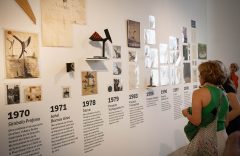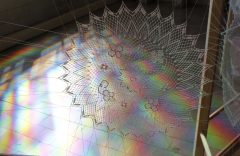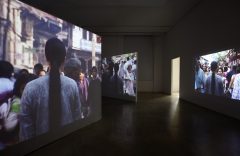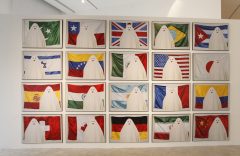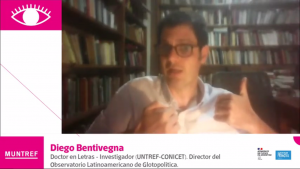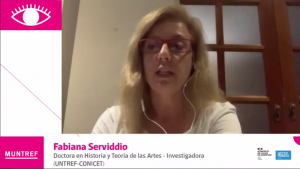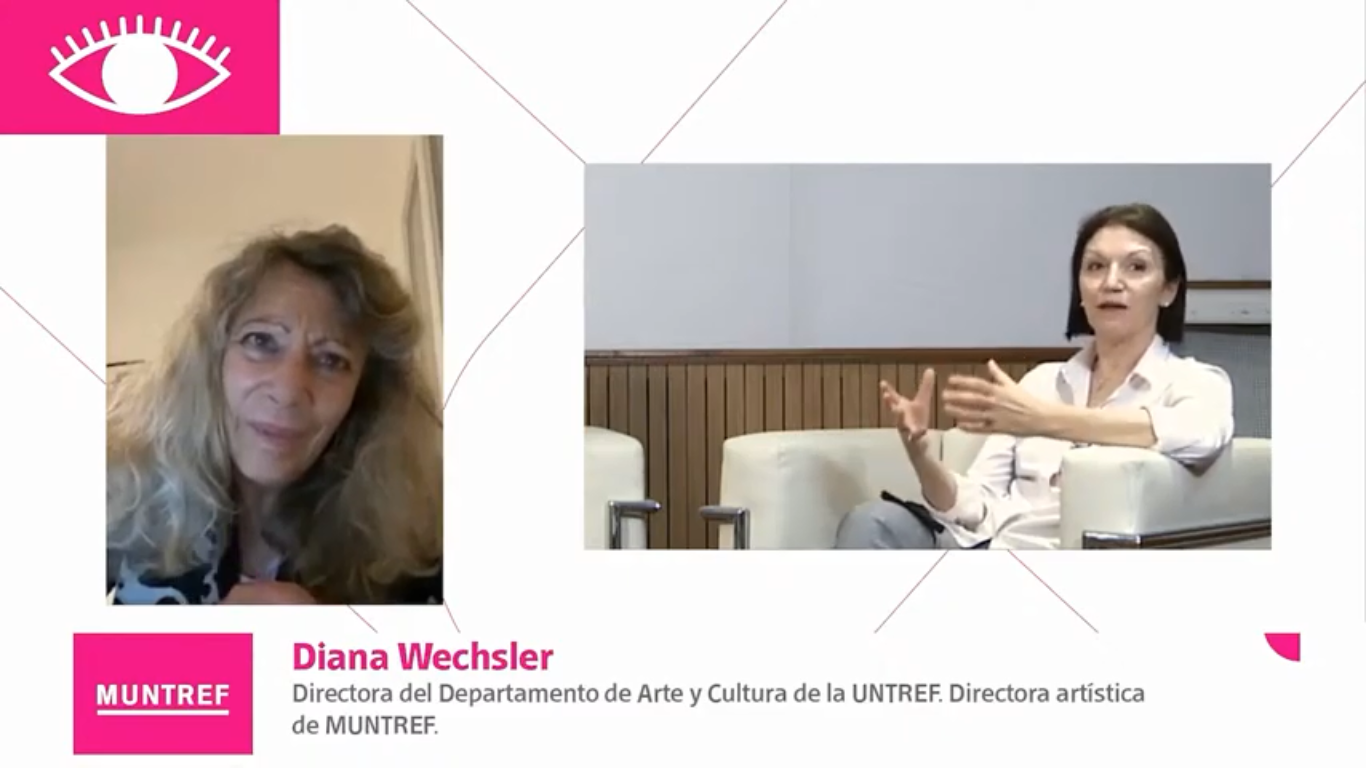
It was through two online talks in which the curators, MUNTREF authorities and specialists from the University discussed the possibility of projection the sample has towards thinking about politics in everyday life.
The public programs around the exhibition After Babel. Translations from the Rio de la Plata, hosted at the MUNTREF Center of Contemporary Art at the headquarters in the Inmigrants’ Hotel, began with two online conversations in which the participants highlighted the political component that the exhibition houses by proposing coexistence in diversity. These talks and virtual workshops will run until July 2 and can be followed every Friday at 6:00 p.m. from the UNTREF YouTube channel and at the Museum’s website.
One of the curators of the exhibition, the French philologist Barbara Cassin, from the Académie Française/CNRS, pointed out that the proposal was to question the idea of Babel as a curse. “Why would it be so terrible to speak different languages, is it not, on the contrary, very good luck to be able to relate them and make something common from what is different?” asked the French academic. The exhibition, Cassin said, focuses on translation as “a know-how between differences” and explores how we go about living, thinking and speaking together. “Today it is about working with what each of us does not have. That is what we need every day in politics and in life”, she added.
In addition, the curator pointed out that the attempts to establish a universal language, from Esperanto to Global English (Goblish), “do not work to integrate”, and remarked that the crossing between languages and cultures is not without tensions. Thus, she is of the opinion that something that characterizes Buenos Aires and Argentina is their cosmopolitanism. “It is extraordinary how the layers of the population (migrants) came to make Argentina and came to cover what was already there to the point that we forgot it”, the philologist evaluated and said that one of the works in the sample, 300 Acts, from Cristina Piffer, speaks very clearly about that. “First we see the name of the Indian, then a date, then the name in Spanish after the baptism. How is it that translation has had the mission of changing the person?
Along with her were the other curators, the members of the Institute for Research in Art and Culture Dr. Norberto Griffa (IIAC-UNTREF), Marina Aguerre and Leandro Martínez Depietri. Depietri said that the exhibition also allows to “think about the diversity of languages that make up a national territory” and exemplified with the case of lunfardo, a vocabulary that is usually associated with Italian but that has contributions from Spanish, Asturian, Quechua, Guaraní and Mapudungun. The curator explained that behind it there is a plot of power, because in the sample it is situated side by side with the first dictionaries that were created by criminalists. “That was the understanding that existed of lunfardo, as a language of crime, a criminals’ secret code. Only later it was began to be recovered as a fundamental part of the cultural heritage in relation to the valorization of tango”, he explained.
Aguerre indicated that even thinking about the possibility that there are non-translatable words or concepts, there is always something new that results from this contact between two dissimilar worlds. “This passage from one language to another also allows the appearance of something different, unexpected, something that enriches. The untranslatable ones can be translated, what happens is that we are constantly looking for another way to translate that term. This can be seen very clearly in the last sections of the exhibition”, she commented.
The Museum’s artistic director, Diana Wechsler, celebrated that After Babel “is full of questions” and that it allows us to reflect on “the condition of contemporary humanism”. She also dedicated a comment to the exhibition site, the historic Immigrants’ Hotel. “When we began, together with UNTREF, to work in this space and we started to imagine what the sounds of this place would be like, the image of Babel quickly appeared, because we identified that there was more than one ship arriving with very different passengers and languages on board. This exhibition is installed with the resonance of everything written in those walls”, she reflected.
Languages, images and concepts in dispute
CONICET researchers Diego Bentivegna, director of the Latin American Observatory of Glotopolitics of the Program for Contemporary and Comparative Latin American Studies (PELCC-UNTREF), and Fabiana Serviddio, of the IIAC, also participated in these programs, addressing certain dominant ideas and values in the fields of knowledge, literature and visual arts.
Bentivegna stated that “English has a hegemonic presence, especially in technology and science” and that there are policies linked to the standardization of knowledge production that need to be revised. Among them, he mentioned the requirement to reproduce summaries in English for the articles that academics propose to publish in magazines that mainly circulate in Spanish. “This has to do with subsidizing our own translations and implies a place of subordination with respect to those who have English as their mother tongue”, he said.
In turn, Serviddio opened the debate to an elusive and problematic concept: that of Latin America. The art historian described that it appears as a 19th century construction that seeks to generate a connection with the Eurocentric legacy and position Central and South America under the protective wing of the French empire against the outpost of the North American empire. “The Latin American is being re-inscribed to that idea that it is the wild, the uncontaminated, the pure, what somehow wants to dominate itself as well, and that will be present in different ways in exhibitions from the 20s until well into the 80s ”, she elaborated.
Serviddio expressed that in these samples generated from the Global North, Latin America appears through different representations of the indigenous as the place of the rural, of the undeveloped, with a very exotic and stereotyped regard, and certain images were privileged in them. “There were things that the artistic productions did not show, because if we see photos of Manuel Álvarez Bravo, a Mexican photographer who reveals the two realities, the urban contemporaneity and the pre-eminence of an indigenous tradition in the Mexico of the 40s, those images were not chosen”, she exemplified.
According to the researcher, at the end of the 20th century there is a great reaction from the local curatorship and historiography that led to the rethinking of these questions to begin to imagine “a fragmented Latin America with situated and specific productions”. For his part, Bentivegna assured that “Latin America” is a concept to be re-appropriated, and that “America” can be spoken of in broader terms, as did two of our great writers, the Chilean Gabriela Mistral and the Cuban José Lezama Lima. “In her last poem, Mistral speaks of an America without a name, as a space of the future that is projected politically. To think of the American condition as a non-worldly condition, as a space for the new, certainly seems interesting to me”, concluded the literature scholar.
The next virtual debates around After Babel will feature the participation of artists such as Sebastián Tedesco, Hugo Vidal, Cristina Piffer, Nicolás Martella, Lihuel González, Nurith Aviv and Gabriel Valansi. Experts such as the director of the Center for Research in Art, Matter and Culture (MATERIA) of the University, Gabriela Siracusano, and diplomatic representatives such as the Moroccan ambassador in Argentina, Fares Yassir, amongst many others, will also be taking part.
News

